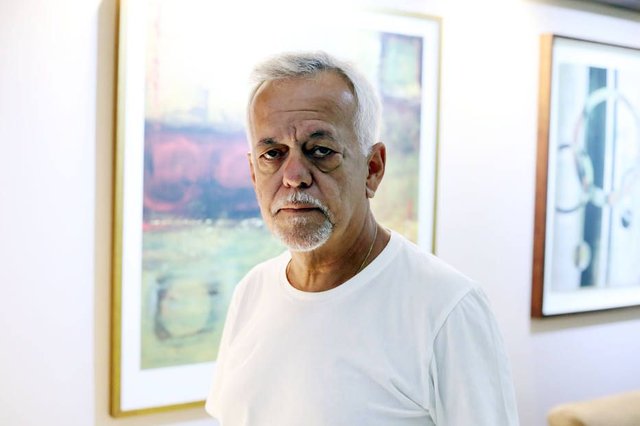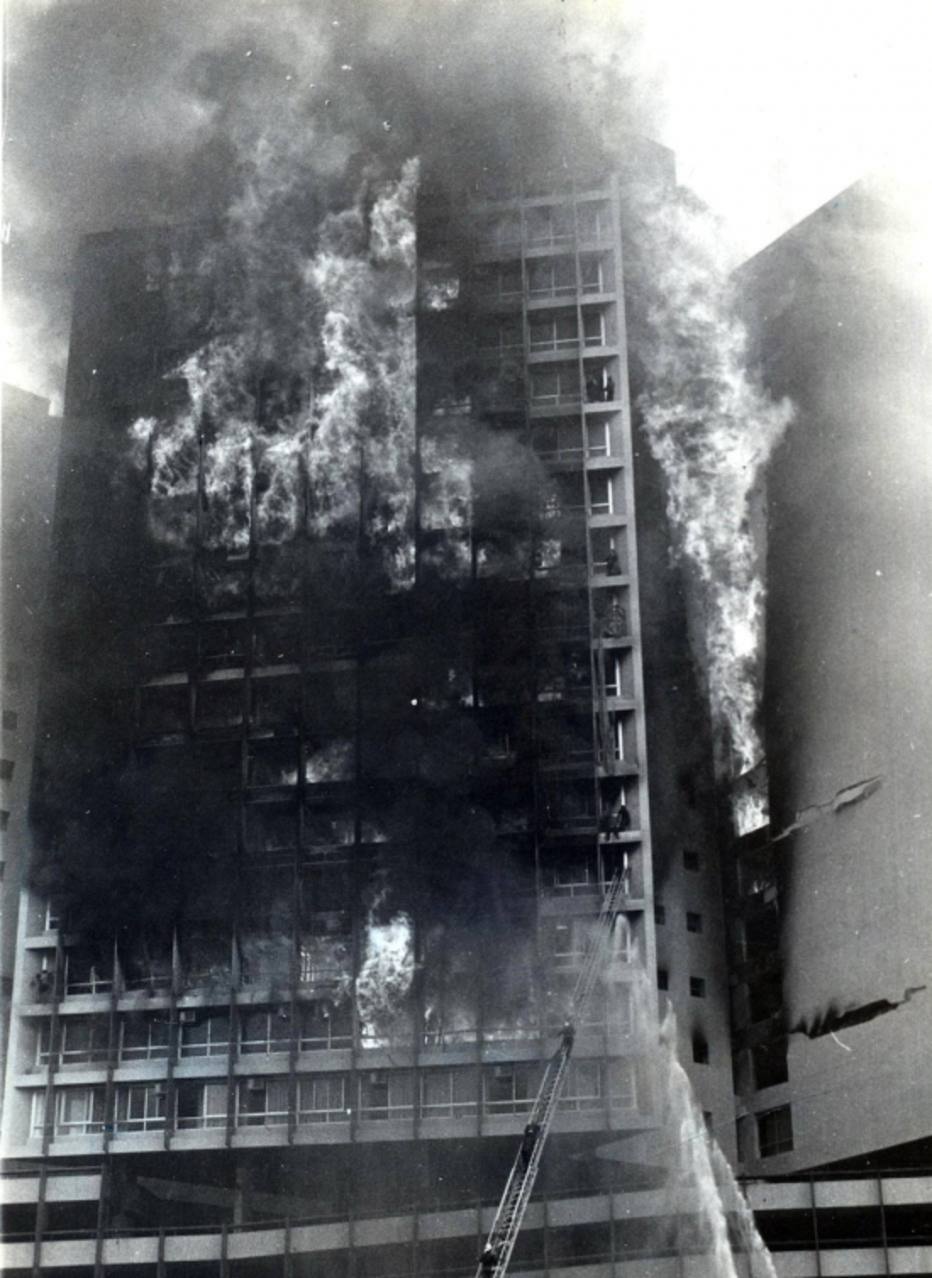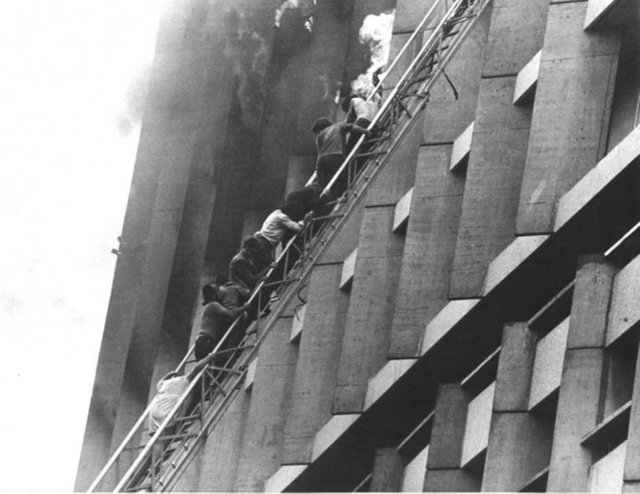'When I see fire, everything comes back to my mind'

This article was written by Fabio de Castro from O Estado de Sao Paulo newspaper. The reason I proudly translated his work is that this gentleman pictured on the front page is my father, a survivor of Brazil’s biggest fire tragedy in its history. Although I cannot compare, in 2012 the place I worked for also got on fire, The Electric Cinema in Portobello Road. I was one of the last to leave the building, no panic, no deaths and thankfully very safe. However, I remember calling my father from outside saying “we got one more thing in common dad”
In 1974, Edson Sant'Anna was 19 years old and worked in the Joelma building, but he only understood the size of the disaster when he left the building: "When I arrived on the pavement there were already bodies of people who threw themselves out of the building. I looked up and saw the flames. It was a shock. " Photo: Alex Silva / Estadão
Collapsing in Largo do Paiçandu makes survivors remember other tragedies
More than four decades later, the fires of the Andraus building and the Joelma building - both in the centre of São Paulo still mark the memory of many Paulistas. "It's very sad to remember, even so, many years later. And when I see the image of a fire, it all comes back to my mind, "says insurance broker Edson Sant'Anna, 63, one of the survivors of the Joelma fire.
On February 1st, 1974, this building was the scene of one of the city's greatest tragedies, leaving 187 deaths. Many of them threw themselves out of the window in despair. Officer of a bank inside the Joelma, Mr Sant'Anna tells of having escaped in a matter of minutes. "My post was on the mezzanine, but every Friday I went up to the treasury on the 20th floor to get documents. When the fire started, I had already gone down. "
When someone warned that there was a fire in the place, he did not get scared. "We thought it was a small thing. My colleagues and I still calmly took our personal belongings before leaving. When I got to the pavement there were already corps which got fired. I looked up and saw the flames, it was a shock, "he recalls, that two years earlier he had watched the fire in Andraus, which killed 16 people, from the window of a building in the centre.
Osório Gonçalves, 64, did not have the same luck as Mr Sant'Anna: he worked on the 21st floor of Joelma. "After hours of suffocation, I was with a refugee group in a bathroom. The fire worsened, the heat increased, the windows broke, my lungs were burning. My ears were burned, I struggled not to faint. We could hear screams from people who were throwing themselves from the windows".
During the rescue, Osorio was on the 19th floor but the firemen's ladder only reached the 13th. It was necessary to go down several floors by curtains dangerously tied to the columns. "A girl who was with me slipped and died. I was only 20, but I do not forget, "he says.

On February 1, 1974, the flames completely took over the Joelma building in the centre, killing 187 people. Photo: Acervo / Estadão
Memory. Andraus' survivor, Walter Sperandio, 68, vividly remembered that day of terror by watching on TV the building that collapsed on Largo Paiçandu last Tuesday, when a man was rescued. "That was my biggest fear. I was sheltering in a staircase where the flames did not come, but I saw the violence of the fire reflected in the neighbouring buildings. I thought the structure would collapse, "he says.
"To this day, when I walk into a building, or even in a movie theatre, the first thing I do is locate the emergency exits," says accountant Pedro, who also survived the Andraus fire.
Firefighters removed more than a thousand tons of debris from the building that collapsed
Late changes. The disaster at the Joelma Building in 1974 led to a complete change in building security and fire prevention standards. A week after the tragedy, a decree of the Prefecture fixed norms on the subject. And in that same year, they resumed discussions to revise the 1934 São Paulo Code of Works, which had never been revised before, to update the law for the new urban structure.
"While I was rescuing at Joelma, I was disgusted, because two years ago, after the Andraus fire, public managers promised to update the Code, but they did absolutely nothing," says Colonel Nilton D'Addio of the Nucleus of Research. The memory of the Fire Department.

A group of people escaped by a Fire Department ladder during the fire that killed 187 people in the Joelma building in the centre of São Paulo in February 1974; the building had no fire escape or helipad. Photo: Estacao Estadão
"Today such a fire would not occur. The buildings have fire doors, fire alarms, handrails, emergency lights, anti-panic doors, fire extinguishers, fire hydrants, escape routes and evacuation plans. Joelma's catastrophe served at least so that these things could be revised, "says the Colonel. Currently, in addition to local regulations, the Brazilian Association of Technical Standards (ABNT) and the Consumer Protection Code provide for fire prevention standards.
According to Mr D'Addio, the fire in the Andraus building was much more violent, but the conditions of survival were much better than in Joelma. Most Andraus survivors were rescued by the helipad, which did not exist in Joelma.
"The Andraus had a staircase facing the back of the building and isolated on every floor with a common door. In addition, the wind was blowing favourably, taking the flames to the opposite side of the ladder. If it were not for these conditions, that would be a carnage, "D'Addio explains.
At Joelma, there were no outside stairs. To make matters worse, the internal stairs worked like a chimney. "People remembered Andraus and went up to the terrace to be rescued, but there was nowhere to stay."